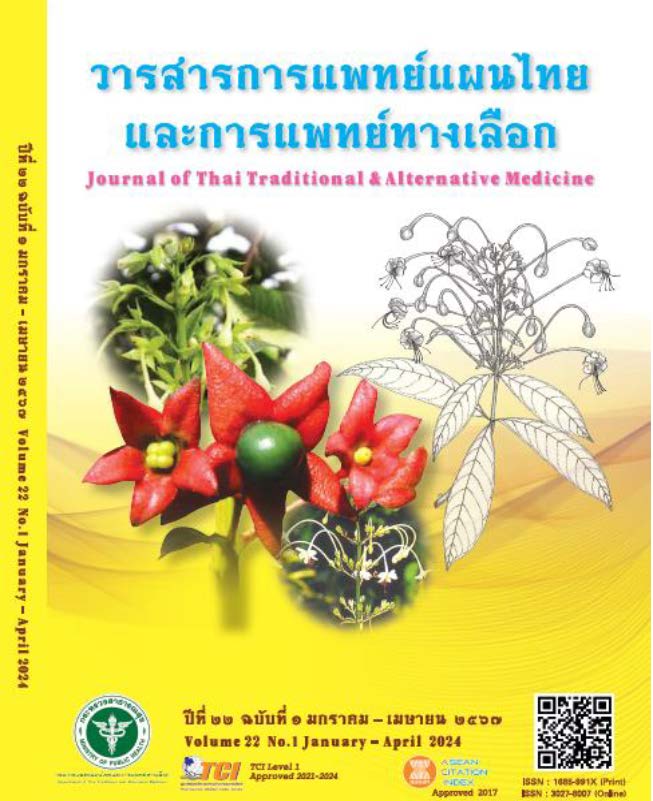Development of Bartunita Aromatherapy Oil to Help Relieve Pain and Stiffness in the Lower Muscles Among Farmers
Main Article Content
Abstract
Introduction and objective: Low back pain is a serious symptom as its impact will decrease the patient's quality of life. In Thailand’s three southern border provinces, there are plenty of Strobilanthes crispa Blume trees, locally known as bartunita or Hin Fa Laep trees and used as medicinal plants. The plant is rich in chemical compounds essentially used for pain relief and as an anti-inflammatory drug. Therefore, the researcher is interested in developing an aroma oil with the main ingredient being bartunita leaves to help relieve lower back pain and stiffness among farmers.
Methods: The research was conducted in three stages: Step1: Determine the situation of lower back pain. A purposive sampling method was used for recruiting 14 participants. A questionnaire and group discussions were employed for data collection. Step2: Develop bartunita aroma oil from eight herbs. Step3: Explore the efficacy of and satisfaction with the bartunita aroma oil by assessing the pain levels before and after using aromatherapy oil in 27 participants. The Wilcoxon signed-rank test was used to analyze the data, and descriptive statistics were used to determine patient satisfaction.
Results: Among the participants, most of them (77.8%) had low back pain and stiffness caused by occupations. Furthermore, previously used packages were too big and difficult to utilize. After using the bartunita aroma oil, the lower back pain level dropped significantly compared with before (P = 0.05). Their satisfaction levels with the product's quality and style were high and highest, respectively.
Discussion: The developed bartunita aroma oil contained eight herbal extracts or products from ginger, cloves, black sesame, bergamot essential oil, lavender essential oil, eucalyptus essential oil and coconut oil. In particular, the key ingredient was bartunita leaves obtained from bartunita plant in the family Acanthaceae, which has important properties for reducing muscle aches and inflammation. In addition, eucalyptus essential oil has pain-relieving and anti-inflammatory effects. It is possible that the action of bartunita aroma oil on reducing lower back pain is likely due to the activities and chemical composition of all the ingredients used in the extraction of bartunita aroma oil.
Conclusion: Bartunita aroma oil can be used as a therapeutic option for people with lower back pain. It can also be utilized as a starting point for developing aromatherapy oils to assist in decreasing pain and stiffness in various sections of the body.
Article Details

This work is licensed under a Creative Commons Attribution-NonCommercial-NoDerivatives 4.0 International License.
References
Tonchoy P, Suta P. Ergonomic risk factors of musculoskeletal disorders among ethnical maize farmer groups, Chiang Rai Province. The Office of Disease Prevention and Control 7 Khon Kaen. 2019;1(27):27-39. (in Thai)
Chuppawa1 W, Turnbull N, Chada W, Sae-Ung K, Chooppava C. Prevalence and work posture factors in relation to musculoskeletal disorders among sewing farmers. Research and Development Health System Journal. 2022;1(15):17-27. (in Thai)
Department of Disease Control. Health surveillance system for occupational and environmental diseases; 2018. [cited 2023 May 1]. Available from: http://inenvocc. ddc.moph.go.th/envoccsmart/app/knowledge/detail/3. (in Thai)
Kinkade S. Evaluation and treatment of acute low back pain. American family physician. 2007;75(8):1181-8.
Vika R. Overview of Phytochemicals and Pharmacological Activity of Keji Beling Plant (Strobilanthes crispus Bl.). International Journal of Pharmaceutical Sciences and Medicine (IJPSM). 2021;6(7):25-39.
Faul F, Erdfelder E, Lang AG, Buchner A. G* Power 3: A flexible statistical power analysis program for the social, behavioral, and biomedical sciences. Behavior research methods. 2007;39(2):175-91.
Best JW, Kahn JV. Research in Education. (3rd ed). New Jersey: Pearson Prentice Hall; 2006.
Narongsak T, Chimnakboon N, Chaiyachat S. Associated factor of low back pain in personnel’s of somdet chaopraya institute of psychiatry. 2019;13(1):21-33. (in Thai)
Wongsa S. The prevalence of low back pain among Phayao hospital personnel. 2012:4(2):35-42. (in Thai)
Heneweer H, Staes F, Aufdemkampe G, van Rijn M, Vanhees L. Physical activity and low back pain: a systematic review of recent literature. European Spine Journal. 2011;20:826-45.
Dangdet P. Factors Affecting the Purchase Decision of Pain Relief Products Made from Herbs for Consumers in the Area Bangkok; 2016. [cited 2023 May 1]. Available from: http://dspace.bu.ac.th/bitstream/123456789/2143/1/preyanuch_dang.pdf (in Thai)
Reamrimmadun W. Biodiversity and Local Wisdom of the Family Acanthaceae in Changwat Nakhon Ratchasima. Ratchaphruek Journal. 2557;8(3):160-6. (in Thai)
Kumar KS, Vijayan V, Bhaskar S, Krishnan K, Shalini V, Helen A. Anti-inflammatory potential of an ethyl acetate fraction isolated from Justicia gendarussa roots through inhibition of iNOS and COX-2 expression via NF-κB pathway. Cellular Immunology. 2012;272(2):283-9
Silva J, Abebe W, Sousa SM, Duarte VG, Machado MI, Matos FJ. Analgesic and anti-inflammatory effects of essential
oils of Eucalyptus. Journal of ethnopharmacology. 2003;89(2-3):277-83.


